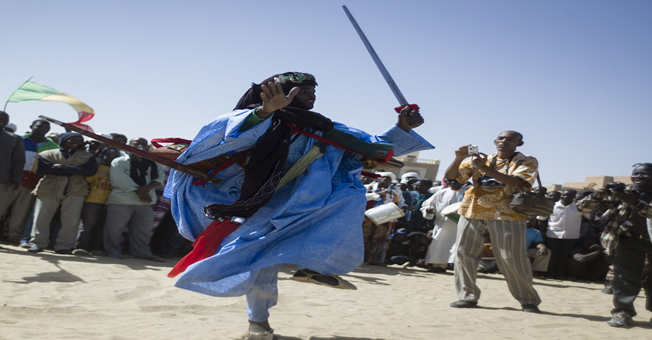International Criminal Court, Chief Prosecutor, Fatou Bensouda’s abridged statement at the opening of the trial in the case against Ahmad Al-Faqi Al Mahdi, who is facing war crime charges for the destruction of historical and cultural monuments in Timbuktu, Mali.
Today’s trial is indeed historic.
It must be said, and it must be said clearly: to intentionally direct an attack against historic monuments and buildings dedicated to religion constitutes a war crime, duly punishable under the Rome Statute. These are serious crimes which must be dealt with at the hands of justice.
And it is all the more historic in view of the destructive rage that marks our times,
in which humanity’s common heritage is subject to repeated and planned ravages by individuals and groups whose goal is to eradicate any representation of a world that differs from theirs by eliminating the physical manifestations that are at the heart of communities. The differences and values of these communities are thus simply denied and annihilated.
This is the essence, the very heart of this case. What makes this crime so serious is the fact that it is a profound attack on the identity, the memory and, therefore, the future of entire populations.
This is a crime against that which constitutes the richness of whole communities. And it is thus a crime that impoverishes us all and damages universal values we are bound to protect.
The evidence that my Office has collected will take you to Timbuktu: a city that was desecrated; a city that was oppressed; a city that was scarred within a period of some ten days between June and July 2012.
Timbuktu, a city that was disfigured so profoundly that its people were wounded to the depths of their soul, forever marking that painful and dark chapter in the history of the city.
Allow me to describe what the mausoleums of the Muslim saints of Timbuktu represent, the meaning they bear and the function they have fulfilled, for many, over centuries.
Timbuktu is indeed an ancient and vibrant city.
Timbuktu’s name is one that is commonly associated with a rich history and culture.
In the 15th and 16th centuries, Timbuktu became a regional centre of economic activity and trade. More importantly, it blossomed into one of Africa’s most vibrant intellectual and spiritual capitals.
It played an essential role in the expansion of Islam in Africa.
It was, to be sure, the cradle of education, where enlightenment was nurtured for the benefit of generations of students, attracting scholars from far and wide.
Some of these sages would be venerated as Muslim saints, and mausoleums would be erected on their graves to honour their memory as well as the notable contributions they made to the lives of the people of Timbuktu, and beyond.
These mausoleums, which survived the ravages of time, have continued to play a fundamental, even foundational, role in both the life within the city’s gates and beyond the city’s borders.
These monuments were living testimony to Timbuktu’s glorious past.
These mausoleums undoubtedly also served as a unique testament to the city’s urban settlements. But above all, they were the embodiment of Malian history, captured in tangible form, from an era long gone yet still very much vivid in the memory and pride of the people who so dearly cherished them.
The mausoleums also testify to the historical role Timbuktu played in the spread of Islam in Africa and in the history of Africa itself.
They are relics of a great chapter in humankind’s intellectual and spiritual development on the continent, which gave Timbuktu its standing in the world. This is particularly important in a society that is partly rooted in oral tradition. And it is notably for these reasons that they are so precious, and were inscribed on the World Heritage list in 1988.
Additionally, the mausoleums played a key role in fostering the social cohesion that is so characteristic of Timbuktu.
The mausoleums are related to families who take care of them and resort, when needed, to masons. These masons are considered to be “living human treasures” for their unique craftsmanship.
And while they are the ones who maintain these buildings, the renovation of a mausoleum is a task in which the entire community joins and participates. Everyone helps the masons. At the level of neighbourhoods, materials are collected and meetings are held. It is an event that brings together and unites worshippers, different age groups and the community as a whole.
Those are not the only social functions linked to the mausoleums. The mausoleums – which were destroyed – also contributed greatly to what I would call “the workshop of peaceful coexistence.”
Timbuktu is known as the “City of 333 Saints”. The mausoleums were the contemporary living symbol of the city. As one resident of the city declared at the time of the destructions, and I quote: “The people are very, very angry today because the mausoleum is the symbol of Timbuktu.”
To destroy Timbuktu’s mausoleums is therefore to erase an element of collective identity built through the ages. It is to eradicate a civilisation’s landmark.
It is the destruction of the roots of an entire people, which irremediably affects its social attitudes, practices and structures. Another inhabitant of Timbuktu summarised this notion as follows: “Timbuktu is on the verge of losing her soul; Timbuktu is threatened by outrageous acts of vandalism; Timbuktu is being held under a sharpened blade ready for use in a cold-blooded murder.”
Read the rest of the statement here: Statement of the Prosecutor of the International Criminal Court, Fatou Bensouda, at the opening of Trial in the case against Mr Ahmad Al-Faqi Al Mahdi







